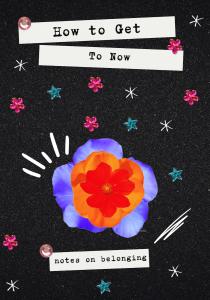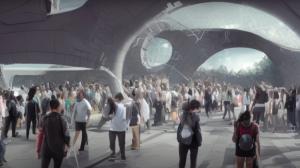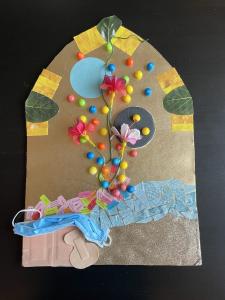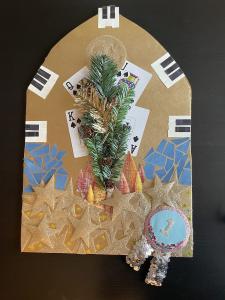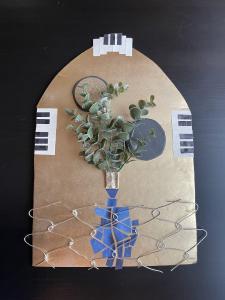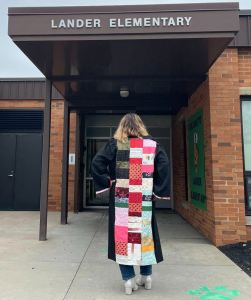Student Work from the MA in Learning, Design, & Technology
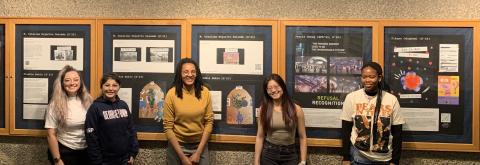
How might we reimagine, transform, and reorient higher education toward an anti-racist future?
This gallery features the work of students in the MA in Learning, Design, and Technology program's Fall 2022 class entitled Critical Speculative Design for Anti-Racism in Higher Education. During the semester, the class turned to scholarly articles as well as poetry, speculative science fiction, comics, and visual arts to imagine new and just paths for the future of education.
For their final projects, students created artifacts from (re)imagined learning experiences designed for anti-racist and equitable futures in higher education.
How to get to now: notes on belonging
Fikayo Odugbemi, G‘24
“What if we were suddenly all thrust into a classroom together—people of different classes, different races, different cultural backgrounds? how should that classroom operate? what conditions need to be met?”
This zine serves as a unique artifact from the present, transported to the past. It tells the story of how an institution fostered a multicultural, inclusive, and equitable learning experience. Zines have historically been leveraged as a tool to subvert oppressive structures. They provide a window to an alternative world, where those on the margins of history, whose mere existence is political resistance, can reimagine and tinker with reality.
Georgetown: Imaginable Future(s)
Jessie Cheng, SFS '23, G‘24
2022
AI art, iMovie, Georgetown Voice articles, projection media
Why do we learn what we learn? Who do we learn it from? How do we learn it? What is Georgetown’s unimaginable future?
This piece questions the historical and cultural roots of academic knowledge that is passed to students. The work examines the process of thoughtlessness that occurs during knowledge acquisition, breaking down the mindless reproduction of knowledge that is rooted in colonial histories. The projection also features an interactive component where students can identify the ways the university restrains learning, as well as imagine what contributes towards the decolonization of knowledge.
Lenticular History: The "New" World
M. Catalina Pajarito Caicedo, G '23
Printed images were cut and pasted on a cardstock piece which was folded to create the lenticular effect on top of a black cardboard background.
What if the victors were not the only ones telling history?
There are always multiple effects and points of view in one historical event. Instead of having two pictures side by side, lenticular images allow us to see images interwoven in the same space, simulating how history happens. One side has the most known version of history, and the other shows other versions and points of view by people who are historically not recognized or underrepresented.
Lenticular History: The Washington March
M Catalina Pajarito Caicedo, G’ 23
2022
Printed images cut and pasted on a cardstock piece which was folded to create the lenticular effect on top of a black cardboard background.
Lenticular History: The Abolitionists
M Catalina Pajarito Caicedo, G’ 23
2022
Printed images cut and pasted on a cardstock piece which was folded to create the lenticular effect on top of a black cardboard background.
Lenticular History: The 60s Future
M Catalina Pajarito Caicedo, G’23
2022
Printed images cut and pasted on a cardstock piece which was folded to create the lenticular effect on top of a black cardboard background.
Identity Collage Triptych for Liberation: Purpose, Rest, and Unbridled Joy
Frankie Rubio, G '23
“If you lived in a future where you did not have to do anti-racist, DEI, social justice work, what would you spend your time doing? Where else might you find purpose? Rest? Unbridled joy?”
These questions prompted education professionals to speculate on what their lives and identities would look like in a world without racism. Breaking free from competition, from the propensity to be stuck in the mundane, and from inaccessible healthcare systems, interviewees described glimpses of a vibrant life full of self-actualization and joy. Their responses inspired collages created by the artist.
“I think in that world rest just comes naturally like breathing or swallowing. It wouldn’t be something I’d have to think about or be intentionally planned… I would be listening to my body instead of fighting my body all the time…Warm sunny day, bright blue sky, clear ocean water, just being out there with no schedule constraints, no noise pollution, within reach, when desired, with people that I care about that I’d like to connect with.”
Dr. Jo Ellyn Walker
Frankie Rubio, G’23
December 2022
Multi-media collage on poster board: wire, magazine clippings, faux flowers.
“I think in that world rest just comes naturally like breathing or swallowing. It wouldn’t be something I’d have to think about or be intentionally planned… I would be listening to my body instead of fighting my body all the time…Warm sunny day, bright blue sky, clear ocean water, just being out there with no schedule constraints, no noise pollution, within reach, when desired, with people that I care about that I’d like to connect with.”
Caylah Green
Frankie Rubio, G’23
December 2022
Multi-media collage on poster board: wire, magazine clippings, faux flowers.
“If I had time to not worry about all of those things
I would be in the forest
Have a garden
Eat from the land
Play at least 3 instruments
Sing
Produce music
Paint
Make every single meal that I eat, art
I would find so much joy in living very simply
I wouldn’t need much”
Albert Ramirez
Frankie Rubio, G’23
December 2022
Multi-media collage on poster board: wire, magazine clippings, faux flowers.
“What do we lose collectively because people are poor and struggling and suffering? There is a net loss of creativity in the world; what would people get to do if they didn’t have to focus on survival? The ways I build community, creativity, and connection, that’s where I would find purpose, rest, and unbridled joy.”
Dust & Rainbows
Lauren Jacobson, G'23
2022
Fabric, batting, graduation robe, and other academic memorabilia.
This project is a reflection of my educational journey. My guiding questions were inspired by and adapted from Black Imagination: Black Voices on Black Futures:
- What is your educational origin story? How did you get to where you are today?
- How do you heal yourself?
- Imagine a higher education institution where you are loved, safe, and valued. What does that look like? What about an educational future where you are loved, safe, and valued? What does that look like?
I responded to these questions through my own written reflections and the constructions of my quilted garment.
The garment is a graduation robe, affixed with the quilt I constructed which traces my educational journey. After constructing the garment, I wore the quilt and took photographs at important places from my educational journey to better understand the struggle and transformation I experienced throughout my journey.
This exhibition was curated by Professor Ijeoma Njaka, Senior Designer for Equity in the Red House, and Adjunct Professor, Learning, Design, & Technology.

